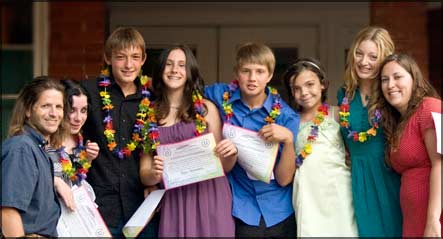How Rainbow Prepares Our Children for High School and Experiences Beyond Rainbow

As parents we assume – by default – the role of teacher, whether we’re predisposed to it or not.
And most of us might agree that if we were only able to pass on one life-lesson to our children, just one, that it might very well be to teach them to think for themselves.
Daily, in subtle (and not so subtle) ways, we have “for generations“ done our best to reinforce the idea. Don’t worry about what everyone else is doing; if they jumped off a cliff would you?
Or, conversely, maybe we take a more hands-on approach and model the behavior ourselves (doing our own research prior to a doctor’s visit or opting for a short-cut vs. the main-road).
Of course, we’re all familiar with the old adage, “Give a man a fish; feed him for a day. Teach a man to fish; feed him for a lifetime particularly, in the education circles.
However, since it is still as true today as it was in 4-6th century BC when Lao Tzu coined the phrase, no wonder it’s till circulating.
If you teach a man to fish he will (hopefully) learn how to fish. But what if he doesn’t care for fish, or, like most of us, would prefer a more varied diet? What if he longs for rabbit, blackberries or a thick, juicy char-grilled portabella?
In fact, instead of teaching him one specific bit of information (how to fish) wouldn’t it be better to teach him a cognitive process he could apply towards anything? Wouldn’t it be ideal if you weren’t just teaching one man, but several together, who could mutually benefit from their shared experience and dialogue? Who could then take the analytical power you’ve invested in them out into the great big world and thrive?
I don’t know about you, but I am the product of a public education. We moved around a lot when I was growing up and I attended several school districts. Some better, some worse; overall, my education was a mixed bag. I can’t say how it compared to others, but I can say – with absolute conviction – that I did not really learn how to think for myself until I went to university. Not properly. Though I completed my last two years of high school in the same state in which I would later go on to university (California), once I got there, I – and many others I knew – struggled. There seemed to be collective feeling of despair at the educational chasm that faced us. Yes, we’d had some good, perhaps even great, teachers. But we’d still left a system largely fueled by textbook-led lectures, rote memorization and multiple-choice tests. The road was clear and easily navigated: the teacher talked, you followed the page in front of you; you studied. Then you fastened your seat belt, took out your carefully sharpened #2, and (quickly!) maneuvered your way through the bubbles. Suffice to say, I had little to fall back on when I was later faced, as a student at UC Santa Cruz, with the task of writing a 15-20pp paper on a poem from the traditional canon. I remember I choose Donne’s “Valediction Mourning†and that I received the worse marks (well, evaluation; back then UCSC still did evaluations) I’d ever received. I was shocked; I’d always believed I was good at English. Further, I was mortified to discover that in some classes I would be expected to lead lectures. For, up until then, I had managed (rather successfully) to escape getting up in front of the class for any considerable length of time.
If you’re still with me, I apologize for the delay in getting to my point. It’s taken me awhile to set the stage, but the reason I’ve gone into such personal (and hopefully not painful) detail is that I believe that for those of us who’ve gone through the public system, our experiences probably aren’t that different. In fact, it may be one of the primary things that attracted us as parents to RMCS in the first place…
We wanted something different for our children; something better. After all, their world differs vastly from the one we grew up in; for one thing it’s shrunk considerably. Technological advancements and an increasingly global marketplace have made our kids global citizens now. Yet, according to Wallis and Steptoe’s article in Time, How to Bring Our Schools Out of the 20th Century, “fewer than half of our (public) high school students are enrolled in a foreign-language class†and “the social studies curriculum tends to fixate on U.S. History.â€
It doesn’t really sound like – across the board – that much has changed; does it?
Yet, thanks to the Internet and other technological advancements our kids are exposed to far more information now that they ever were; literally bombarded with TMI. According to a recent article published on PhysOrg.com, researchers predict that “the Internet will double in size every 5.32 yearsâ€. Today, our kids are forced in a way we never were to process information more rapidly, and more intelligently. To not only distinguish a good source from a bad one, but to manage it successfully. (All a long departure from our own childhood when you went to the local library to do a report, and often had to wait days for the book you needed to arrive…)
Yet, one of the parents at the Community Circle Meeting, employed by a leading publisher in education, says she’s noticed an alarming shift lately; from the textbook driving the education system to technology becoming the main vehicle. This in a system that has traditionally placed more importance on teaching content than process.
And all in the face of respected research that directly contradicts such methodology. In the 70’s, the Carnegie Foundation conducted a study on learning and retention. They found that as much as 95% of all learning is “primaryâ€: meaning that which occurs spontaneously through encountering, embracing, and playing with our environment. Further, Allan Schore, a leading researcher in the field of neuropsychology, says (to paraphrase) that the brain is “experience dependentâ€; meaning that the actual growth of individual brain cells, and the learning connections they make, depend on their corresponding interactions with – and responses from – the environment.
Which, as a parent, is one of the things I admire most about RMCS’s curriculum; how it encourages and embraces experiential learning. How it recognizes that thematic, project-based and collaborative learning are vital. At the community circle meeting that day, one former alumnus disclosed that her choice for her independent project one year was Anne Frank, while her brother’s was root beer. Despite the dramatically different subject matter, they both learned a similar process; one that could – in the future – be applied towards anything.(Be it hunting, fishing or foraging.)
Obviously today’s kids need more than a public system that was, according to Wallis and Steptoe, “originally designed to educate workers for agrarian life and industrial-age factoriesâ€. Now, in the 21st century, they need to “ 1) Know more about the world. 2) Think outside the box. 3) Become smarter about new sources of information and 4) Develop good people skills.†As a parent, I firmly believe that RMCS is ticking each – and every – one of these boxes. At the Community Circle meeting Renee said, “I can’t believe this school started in 1977, and just how far ahead it was philosophically.â€
Neither can I. Nor can I believe the panel of former RMCS alumni that were with us that day; all now freshman in the esteemed SILSA program at Asheville High School. I have never seen a group of more mature, more self-aware and more articulate young adults. I kept having to remind myself that they were high school – not university – freshman. Not only were they comfortable speaking to a room full of adults, they were extraordinary. When I compare myself – and my peers at that age – to the young people I saw before me, I feel like another species.  Not only did their testimony about their experiences at RMCS speak volumes, but so did their quiet confidence.  Now well into the first year of high school and all that it notoriously entails, these were not the kind of kids you might worry would lose their way. Instead, what was obvious is that they’re blazing their own, individual paths to the future.
Anyone concerned about the next generation should sit down and have a chat with them.
A special thanks to Sandra McCassim, RMCS’ 1st Grade Teacher, for her enlightening presentation. As well as former alumni: Wyatt Montgomery, Makenzie Peterson, Kaya Greenfield and Shannon Waldman.
Founded in 1977, Rainbow Mountain Children’s School offers a private, independent and alternative educational program for preschool through middle school-aged children that draws from the best in current educational thinking and holistic models of child development. It is recognized nationally as a leader in contemplative education.
Its progressive program supports the development of the whole child in five domains: mental, emotional, moral/social, physical and spiritual.
Marlo Bester-Sproul is a mother of a Rainbow Mountain Preschooler, and a writer and editor. You can reach her at www.writtenbird.com








